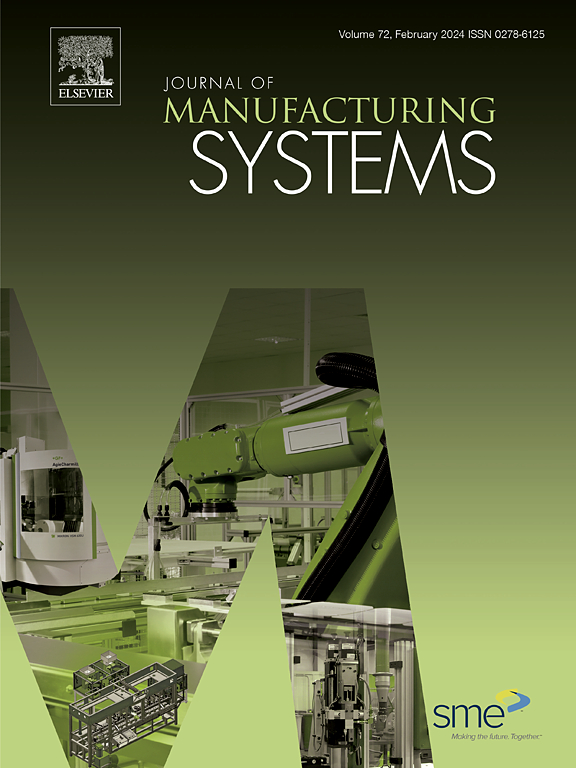通过信息缺失和碎片数据处理对金属成形过程进行“遗传探索”
IF 12.2
1区 工程技术
Q1 ENGINEERING, INDUSTRIAL
引用次数: 0
摘要
超过160,000种工程材料和近90% % (wt%)由金属制成的产品是通过金属成形工艺制造的。大量的金属成形数据每天以更大的规模激增,并从传感网络和实验验证的模拟中收集,促进了对数字制造的科学理解。迄今为止,有限的研究是从数据的角度来研究金属成形的,特别是考虑到大多数数据集都是“信息缺失”,缺乏基本信息,包括单个或多个数据点,或特定数据集或数据库的数据描述,质量或条件或基本特征。此外,传感网络收集的数据最有可能被归类为“碎片数据”,仅包含少数(例如,1-2)基本信息片段。这种现象主要是由于数据收集能力和数据隐私的限制,阻碍了有洞察力的信息的提取。解决这些长期存在的挑战需要一种结合制造和数据科学知识的新兴科学方法。在这里,遵循热机械原理,开发了一种进化二进制(EB)算法来处理信息缺失(元)数据,使用稀疏标记的数据点(≤1 %),对金属成形产品的缺失几何特征进行高效识别,准确率接近95% %。通过利用这项技术,为140多个制造过程确定了独特的数字特征(DC)。数据中心被定义为制造(元)数据的可视化,其中包含跨越设计、制造和制造产品应用阶段的基本信息。这导致了数字特征空间(DCS)的建立,提供了对最新和信息丰富的制造数据中心的访问。采用EB算法,以DCS作为对中参考,成功识别了自然无属性碎片数据(最小长度为25个数据点)的起源,总体精度超过80 %,长度为50个数据点的起源精度约为93 %。本文章由计算机程序翻译,如有差异,请以英文原文为准。
‘Genetic exploration’ of metal forming processes through information absent and fragmental data processing
Over 160,000 engineering materials and nearly 90 % (wt%) of products made from metals are manufactured by metal forming processes. Voluminous metal forming data are proliferated daily at an ever-greater scale, and collected from sensing networks and experimentally verified simulations, facilitating the scientific understanding of digital manufacturing. To date, limited research has approached metal forming from the perspective of data, particularly given that most datasets are ‘information absent’ that lack essential information, including data description, quality or condition, or essential features, for a single or several data points, or a specific dataset or database. Furthermore, data collected by sensing networks are most likely to be categorised as ‘fragmental data’, encompassing only a few (e.g., 1–2) essential pieces of information. This phenomenon is mainly due to limitations of data collection capabilities and data privacy, and hinders the extraction of insightful information. Tackling these long-standing challenges requires an emerging scientific approach combining manufacturing and data science knowledge. Here, following thermo-mechanical principles, an Evolutionary Binary (EB) algorithm was developed to process information absent (meta)data, yielding a highly efficient recognition of missing geometric features for metal formed products with nearly 95 % accuracy using sparsely labelled data points (≤1 %). By leveraging this technology, unique digital characteristics (DC) were identified for over 140 manufacturing processes. The DC are defined as the visualisation of manufacturing (meta)data incorporating essential information spanning design, manufacturing and application stages of manufactured products. This leads to the establishment of digital characteristics space (DCS) that provides access to the up-to-date and information-rich manufacturing DC. Using EB algorithm and taking DCS as an alignment reference, the origins of naturally unattributed fragmental data (minimum length of 25 data points) were successfully identified with overall over 80 % accuracy, and reached approximately 93 % with length of 50 data points.
求助全文
通过发布文献求助,成功后即可免费获取论文全文。
去求助
来源期刊

Journal of Manufacturing Systems
工程技术-工程:工业
CiteScore
23.30
自引率
13.20%
发文量
216
审稿时长
25 days
期刊介绍:
The Journal of Manufacturing Systems is dedicated to showcasing cutting-edge fundamental and applied research in manufacturing at the systems level. Encompassing products, equipment, people, information, control, and support functions, manufacturing systems play a pivotal role in the economical and competitive development, production, delivery, and total lifecycle of products, meeting market and societal needs.
With a commitment to publishing archival scholarly literature, the journal strives to advance the state of the art in manufacturing systems and foster innovation in crafting efficient, robust, and sustainable manufacturing systems. The focus extends from equipment-level considerations to the broader scope of the extended enterprise. The Journal welcomes research addressing challenges across various scales, including nano, micro, and macro-scale manufacturing, and spanning diverse sectors such as aerospace, automotive, energy, and medical device manufacturing.
 求助内容:
求助内容: 应助结果提醒方式:
应助结果提醒方式:


